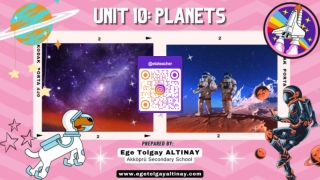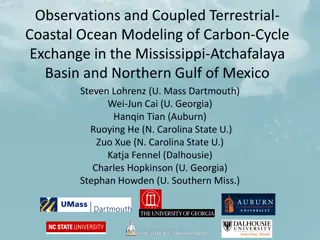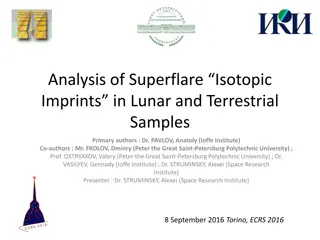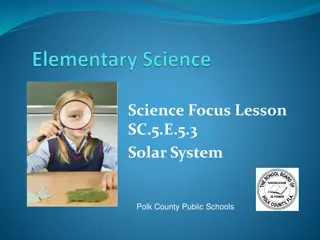The 8 Planets in Our Solar System and More
Discover the 8 planets in our solar system - Jupiter, Earth, Uranus, Mercury, Sun, Mars, Venus, Neptune - plus dwarf planet Pluto. Explore space-related words and images in this educational content.
13 views • 41 slides
Advancements in Solar-Terrestrial Research and Meteorology
The Solar-Terrestrial Centre of Excellence (STCE) focuses on ongoing activities and opportunities in the field of meteorology, with a special emphasis on Antarctica. Their annual meetings cover topics like water vapor feedback mechanisms, extreme weather events forecasting, cloud and precipitation s
0 views • 14 slides
Terrestrial Planets and Core Dynamics
Exploring the core-mantle interaction from the early Hadean period to present times reveals intriguing questions about the outer core's electrical conductivity, geodynamo sustainability, and inner core characteristics. Studies indicate challenges in maintaining the geodynamo, potential heat sources
9 views • 48 slides
Influence of Solar Activity and Orbital Motion on Terrestrial Atmosphere
Solar magnetic field reversal, wavelet spectral analysis, and proxies for solar activity index are discussed in relation to the joint effects of solar activity and solar orbital motion on the Earth's atmosphere. The study highlights the impact of solar cycles on terrestrial climate dynamics and temp
7 views • 16 slides
The History of the Earth
The Earth, 4.5 billion years old, emerged from a nebula in the Milky Way Galaxy. Gravity led to the condensation of a rotating cloud into the Sun and planets. Over time, lumps collided, forming gas giants, rocky planets, and asteroids. The outer planets attracted hydrogen and helium, while the inner
2 views • 45 slides
The Outer Planets: Jupiter and Saturn
Discover fascinating details about the outer planets Jupiter and Saturn, from Jupiter's gaseous composition and iconic Great Red Spot to Saturn's impressive rings and unique characteristics like being the "Ringed Planet." Explore the moons of Jupiter, including the Galilean Moons, and learn about Sa
0 views • 18 slides
Fun Facts About the Solar System and Planets
Explore interesting comparisons between celestial bodies in our Solar System. Images and descriptions highlight the size, temperature, distance, and other unique characteristics of planets like Jupiter, Mars, Earth, Saturn, Neptune, Mercury, Venus, and more. Learn fascinating facts about these cosmi
0 views • 12 slides
Theories on the Origin of Earth and Solar System
Scientists and philosophers have proposed various theories regarding the origin of Earth and our solar system, with concepts ranging from evolutionary to catastrophic. The Dust gas cloud theory, Planetesimal hypothesis, Binary star hypothesis, and more have been suggested to explain how planets were
4 views • 7 slides
Solar System Planets and Market Trends
Discover interesting facts about planets in our solar system alongside market trends analysis. Learn about the sizes, positions, and unique features of Mercury, Saturn, Neptune, Jupiter, Venus, and more. Follow along with engaging visual charts and comparisons. Dive into competition analysis, break-
0 views • 7 slides
Proposal for Enhancing Security in RRC Connection Setup Procedure
Study the security mechanisms to secure the RRC connection setup process for the exchange of sensitive information between authentic network elements (BS and AMF) even before UE authentication. Addressing the lack of security in RRC Msg5 is crucial for various functionalities like Network Slicing an
1 views • 4 slides
Environmental Factors in Terrestrial and Aquatic Environments
Environmental factors play a crucial role in shaping ecosystems. In both terrestrial (land) and aquatic (water) environments, organisms are influenced by abiotic factors such as temperature, light intensity, and pH, as well as biotic factors like plants, predators, and competitors. Understanding the
5 views • 19 slides
Movements of Earth and Planets in Grade 6 Natural Sciences and Technology
Explore the concepts of rotation and revolution in the movements of Earth and planets. Learn about Earth's rotation causing day and night, its revolution around the Sun leading to seasons, and the interactions between Earth, Moon, and Sun in Grade 6 Natural Sciences and Technology.
1 views • 9 slides
Challenges and Opportunities of Georgia's Digital Terrestrial Switchover
The transition to digital terrestrial broadcasting in Georgia posed challenges such as lack of strategy and clear vision in 2012, but also highlighted opportunities like civil society involvement and donor support. Contrasting government and civil society models for digital infrastructure ownership
0 views • 9 slides
Gravity: A Fundamental Force in the Universe
Gravity is a ubiquitous force that attracts celestial objects towards each other, playing a crucial role in keeping planets in their orbits around the Sun and moons around their parent planets. This force, described by Newton's laws, is responsible for phenomena like tides and maintaining the motion
0 views • 7 slides
Coupled Terrestrial-Coastal Modeling of Carbon Exchange in the Gulf of Mexico
Explore the interactions between terrestrial and coastal systems in the Mississippi-Atchafalaya Basin and Northern Gulf of Mexico through coupled terrestrial-coastal ocean modeling. The study focuses on carbon dynamics, uncertainties in coastal carbon budgets, and the NASA IDS project's approach. Fu
4 views • 26 slides
Adaptations and Characteristics of Mammals in Terrestrial Environments
Mammals are well adapted to various terrestrial conditions, inhabiting water, air, and soil. They maintain a stable body temperature, have fur for temperature regulation and protection, and unique limbs for different modes of movement. The distinguishing features of mammals include fur, specialized
0 views • 39 slides
Omnispace: Redefining Global Mobile Connectivity with 5G NTN Technology
Omnispace, launching in December 2022, introduces the world's first global hybrid mobile network using 5G NTN technology to revolutionize mobile connectivity for consumer, enterprise, government, and IoT users. The innovative 5G hybrid architecture combines global NGSO coverage and mobile network ro
1 views • 10 slides
Fun with Weight: Exploring Gravity Across Different Planets
Explore the concept of weight and gravity by comparing how objects weigh differently on Earth, Mars, the Moon, Jupiter, and Saturn. Learn about fractions to estimate weight changes and discover how gravity influences weight variations on different planets and celestial bodies. Get ready for an engag
0 views • 6 slides
Exploring the Solar System: A Fascinating Journey
Delve into the structure of the solar system, with the sun at its center surrounded by planets, asteroids, and comets. Learn about the inner rocky planets, outer gas giants, and tiny dwarf planets. Discover how distance is measured in space using astronomical units and unravel the motion of planets
0 views • 20 slides
The Solar System in a Pocket: Fun Learning Activity
Journey through our solar system in a fun and interactive way with the "Pocket Solar System" activity designed by Ron Thompson. This unique activity allows you to visualize the scale of our solar system by using a strip of tape and simple folds to represent the distances between planets. From the Su
0 views • 17 slides
Integrated Terrestrial-Coastal Ocean Framework for Carbon Management
An advanced framework integrating terrestrial and coastal ocean observations and modeling is developed to support carbon management decisions. The study focuses on assessing the impacts of land use, human activities, and climate scenarios on the carbon cycle, particularly dissolved inorganic carbon
1 views • 5 slides
Analysis of Superflare Isotopic Imprints in Lunar and Terrestrial Samples
Researchers investigate isotopic imprints in lunar and terrestrial samples to understand extreme solar events and their impact on atmospheric radiocarbon concentrations. Using 10Be and 36Cl data, they analyze the solar proton spectra and energy fluxes associated with these events, shedding light on
0 views • 13 slides
The Wonders of the Moon and Planets in Today's Night Sky
Discover the beauty and mystery of the moon, lunar features, and planets visible in the night sky. From lunar craters to phases of the moon, marvel at our celestial neighbors and the fascinating landscapes they hold.
0 views • 16 slides
The Potential for Oxygenic Photosynthesis on Planets Orbiting Red Dwarf Stars
Exploring the possibility of oxygenic photosynthesis and complex life on planets orbiting red dwarf stars, considering factors such as star life cycles, climate conditions, and radiation wavelengths. The evolution of complex life on Earth due to the essential role of oxygen and ozone is discussed in
0 views • 14 slides
Planets: Simple Education Infographics
Dive into the world of planets with these simple education infographics that provide interesting facts about Venus, Mars, Mercury, Jupiter, and more. Learn about each planet's unique characteristics, including their distance from the Sun, composition, and size. Discover fascinating details about the
0 views • 33 slides
Fun Facts About the Eight Planets in Our Solar System
Discover interesting facts about the eight planets in our solar system, from Mercury being the closest to the Sun and shrinking to Venus spinning clockwise and Earth being the only one not named after a god. Learn about Mars' tall mountain, Jupiter's strong magnetic field, and Saturn's position as t
0 views • 18 slides
Exploring the Solar System: Planets, Orbits, and More
Dive into the fascinating world of the solar system with this chapter on Astronomy. Learn about planets, moons, asteroids, comets, and more as they orbit the Sun. Understand the forces of gravity and inertia that keep celestial bodies in motion and explore ancient ideas about planetary motion. Disco
0 views • 26 slides
Exploring the Planets of Our Solar System
Discover the fascinating characteristics of the planets in our solar system, from the rocky surfaces of Mercury and Mars to the thick atmospheres of Venus and Earth, and the gas giants like Jupiter and Saturn. Learn about their sizes, temperatures, moons, and unique features that make each planet di
0 views • 19 slides
Assessing Forest Loss in Protected Areas: A Philippines Case Study
The study assesses forest cover loss in terrestrial protected areas of the Philippines, analyzing the extent and rate of deforestation using Hansen's Global Forest Cover Change datasets. The research aims to understand the drivers of deforestation in protected areas, comparing forest loss in the ent
0 views • 24 slides
Orbits and Kepler's Laws in Astronomy
Orbits and Kepler's Laws play a crucial role in understanding the movement of planets, moons, comets, and binary stars in our universe. Kepler's laws describe the elliptical orbits of planets around the Sun, the equal area law, and the relationship between a planet's distance from the Sun and its or
0 views • 29 slides
Terrestrial ECVs: Fire, Land Cover, Soil Moisture Overview
Detailed examination of Terrestrial Essential Climate Variables (ECVs) focusing on fire monitoring, land cover analysis, and soil moisture assessment. The information encompasses product summaries, error characterization methods, outreach efforts, user statistics, planned activities for phase 2, and
0 views • 8 slides
Space and Beyond: A Journey through Galaxies, Planets, and Stars
Delve into the vast expanse of space, a vacuum devoid of air and filled with celestial wonders. Learn about galaxies like the Milky Way, planets such as Earth, and the twinkling stars that light up the night sky. Understand the fundamental concepts of space exploration and the mysteries that lie bey
0 views • 8 slides
Future of ITU-D Study Question 8/1 Report Analysis
This report delves into the impact of terrestrial television broadcasting coexisting with telecommunication services, focusing on the transition to digital terrestrial television. It covers strategies for analogue switch-off, spectrum planning, and digital dividend use. The report also includes case
0 views • 16 slides
Outer Planets of the Solar System in Grade 6 Science
Discover fascinating details about Jupiter, Saturn, Uranus, and Neptune - the gas giants of our solar system. Learn about their unique characteristics, moons, rings, and distance from the Sun, providing a comprehensive understanding of these distant celestial bodies. Engage with educational resource
0 views • 16 slides
C2.Link 5GHz Band Planning Overview
The C2.Link 5GHz Band Planning involves allocation to AM(R)S, AMS(R)S, and ARNS on a co-primary basis, with ICAO systems and MLS given priority. RTCA MOPS for a terrestrial C2 Link system and EUROCAE MOPS for a geostationary satellite-based system were released. The use of TDD waveforms in RTCA DO-3
0 views • 13 slides
Our Solar System and Orbits
Explore the composition and orbits of our solar system, including the Sun, planets, dwarf planets, moons, comets, asteroids, and artificial satellites. Understand the role of gravity in maintaining nearly circular orbits and discover how objects stay in orbit.
0 views • 11 slides
Hands-On Sessions on Microlensing Planets Exploration
Delve into the world of microlensing planets exploration through hands-on sessions led by Jennifer Yee & Etienne Bachelet. The sessions aim to identify planetary perturbations in light curves, calculate microlensing parameters, perform numerical fits, and analyze the physical properties of planets.
0 views • 9 slides
SAASTA AstroQuiz 2015 Round 3 - Astronomy Questions and Challenges
Test your knowledge of astronomy with a series of questions about stars, planets, spacecraft, and celestial events from the SAASTA AstroQuiz 2015 Round 3. Explore topics such as Proxima Centauri, neutron stars, dwarf planets, blue moons, and planetary sightings in 2015. Challenge yourself and learn
0 views • 39 slides
Terrestrial File Transfer Concept: Design Goals and Protocols
This document discusses the concept of terrestrial file transfer as presented in a series of slides from an ESA event in Noordwijkerhout, The Netherlands. It covers the purpose, design goals, protocols, and transport protocols involved in exchanging files between agencies for mission design, operati
0 views • 20 slides
Surface Temperatures and Albedo in Planetary Systems
Surface temperatures and albedo play significant roles in understanding planetary characteristics. Albedo, the fraction of sunlight reflected from a planet's surface, varies among planets. By considering factors like albedo, distance from the Sun, and energy flux, we can estimate surface temperature
0 views • 10 slides







































